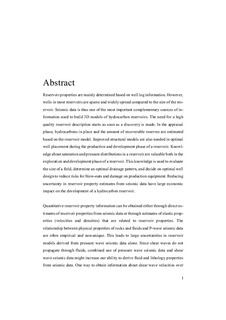| dc.contributor.author | Veire, Helene Hafslund | nb_NO |
| dc.date.accessioned | 2014-12-19T11:19:56Z | |
| dc.date.available | 2014-12-19T11:19:56Z | |
| dc.date.created | 2005-05-02 | nb_NO |
| dc.date.issued | 2005 | nb_NO |
| dc.identifier | 125623 | nb_NO |
| dc.identifier.uri | http://hdl.handle.net/11250/227959 | |
| dc.description.abstract | Reservoir properties are mainly determined based on well log information. However, wells in most reservoirs are sparse and widely spread compared to the size of the reservoir. Seismic data is thus one of the most important complementary sources of information used to build 3D models of hydrocarbon reservoirs. The need for a high quality reservoir description starts as soon as a discovery is made. In the appraisal phase, hydrocarbons in place and the amount of recoverable reserves are estimated based on the reservoir model. Improved structural models are also needed in optimal well placement during the production and development phase of a reservoir. Knowledge about saturation and pressure distributions in a reservoir are valuable both in the exploration and development phase of a reservoir. This knowledge is used to evaluate the size of a field, determine an optimal drainage pattern, and decide on optimal well design to reduce risks for blow-outs and damage on production equipment. Reducing uncertainty in reservoir property estimates from seismic data have large economic impact on the development of a hydrocarbon reservoir.
Quantitative reservoir property information can be obtained either through direct estimates of reservoir properties from seismic data or through estimates of elastic properties (velocities and densities) that are related to reservoir properties. The relationship between physical properties of rocks and fluids and P-wave seismic data are often empirical and non-unique. This leads to large uncertainties in reservoir models derived from pressure wave seismic data alone. Since shear waves do not propagate through fluids, combined use of pressure wave seismic data and shear wave seismic data might increase our ability to derive fluid and lithology properties from seismic data. One way to obtain information about shear wave velocities over a large area is to acquire multicomponent seismic data (for instance x, y, and z component geophone data). Parts of this thesis focus on methods to combine the information from multicomponent seismic data with pressure wave (hydrophone) seismic data. In this way we improve the accuracy in the estimates of pressure wave velocity, shear wave velocity and density in the subsurface.
To obtain information about changes in reservoir parameters like fluid saturation and pore pressure during production, comparisons between different vintages of seismic data acquired over the field can be performed. Differences in the seismic signal from the same area over a time period (time-lapse seismic data) can be interpreted as changes in reservoir properties. Benefits of improved reservoir characterization include ability to locate bypassed oil and mapping of fluid fronts. This leads to saved costs due to reduced number of misplaced wells, and increased production because of optimized well placement. In the early days of seismic reservoir monitoring, the analyses were qualitative, e.g. to identify undrained areas, analyzing the sealing capacity of faults, and detect drainage patterns. Today, time-lapse seismic analysis is still mainly qualitative. To be able to obtain more quantitative estimates of changes in reservoir properties from the time-lapse seismic data, we need to establish links between the rock parameters and the seismic data. I have used both time-lapse surface seismic data and time-lapse multicomponent seismic data to estimate production related changes in fluid saturation and pressure.
Finally, to be able to utilize rock physical information obtained from seismic reservoir characterization in reservoir modelling, information about uncertainties in the estimates are essential. One way to do this is to use deterministic models (rock physics models) that relates reservoir properties to seismic data, and assume that the model parameters are independent. However, the variables in these estimations are inherently dependent and should be treated as such. By formulating the problem in a Bayesian framework, dependencies between the different variables and spatial dependencies can easily be included. I have used both deterministic uncertainty analysis and Bayesian estimation methods to quantify uncertainties in the estimates. | nb_NO |
| dc.language | eng | nb_NO |
| dc.publisher | Fakultet for ingeniørvitenskap og teknologi | nb_NO |
| dc.relation.ispartofseries | Doktoravhandlinger ved NTNU, 1503-8181; 2005:85 | nb_NO |
| dc.relation.haspart | Landrø, M; Veire, HH; Duffaut, K; Najjar, N. Discrimination between pressure and fluid saturation changes from marine multicomponent time-lapse seismic data. Geophysics. 68: 1592-1599, 2003. | nb_NO |
| dc.subject | Geophysics | en_GB |
| dc.subject | NATURAL SCIENCES: Physics: Other physics: Geophysics | en_GB |
| dc.title | Combined Inversion of PP and PS Seismic Data for Static and Dynamic Reservoir Characterization | nb_NO |
| dc.type | Doctoral thesis | nb_NO |
| dc.contributor.department | Norges teknisk-naturvitenskapelige universitet | nb_NO |
| dc.description.degree | dr.ing. | nb_NO |
| dc.description.degree | dr.ing. | en_GB |
